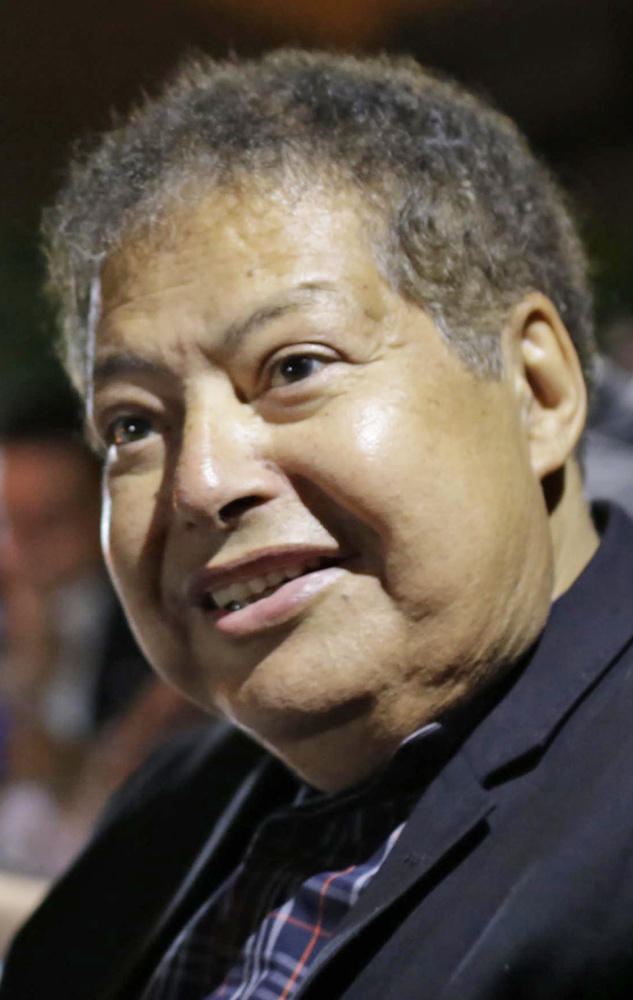Ahmed H. Zewail, a winner of the Nobel Prize in chemistry who grew up on the banks of the Nile river in Egypt and used the heat from his mother’s Arabic coffee maker in one of his earliest excursions into science, died Aug. 2. He was 70.
The California Institute of Technology, the Pasadena-based university where he had been a faculty member and administrator for years, announced the death but did not provide further information. He was a resident of San Marino, a suburb of Los Angeles.
Zewail, the first Egyptian and Arab to win a Nobel in science, fulfilled the ambitions of his devoted mother, who, well before he received his Ph.D., hung on his door in the family home a sign declaring him “Dr. Ahmed.”
He received the Nobel in 1999 for work that used lasers to probe the intricacies of chemical reactions as they occurred step by step, instant by instant over intervals of time almost too small to imagine.
His pioneering work came in an area known by the exotic sounding name of femtochemistry, where femto is a prefix used to suggest quantities and time intervals on the order of a millionth of a billionth of those encountered in the everyday world.
Pulses produced on such a scale by laser made it possible for Zewail to speak of chemical reactions and transformations occurring over areas of atomic dimensions and within almost infinitesimally small moments of time.
Just as slow-motion photography revealed aspects of common events hidden from the scrutiny of the unaided human senses, “femto” techniques, embodying laser capabilities, gave science new insights into how chemical reactions proceed.
“Professor Zewail’s contributions have brought about a revolution in chemistry and adjacent sciences, since this type of investigation allows us to understand and predict important reactions,” the Royal Swedish Academy of Sciences announced at the time of the Nobel awards ceremony.
With such advances, it became possible to watch as chemical bonds formed, broke and formed again. It offered the opportunity to witness each step of the process by which atoms and molecules absorbed energy and expelled it, or exchanged it, or used it to rotate and vibrate.
Permitting unprecedented understanding of chemical behavior at its most detailed, Dr. Zewail’s advances in femtochemistry pointed the way to greater control over the actions of atoms and molecules. It enhanced scientists’ ability to create new compounds and to manipulate old ones.
Ahmed Hassan Zewail was born in Damanhur, a city about 100 miles northwest of Cairo, on Feb. 26, 1946. He grew up in Desouk, another northern city, in a family of four children, and steps away from a landmark mosque whose imam encouraged broad-based learning.
“Education was in the fabric of our culture and religion,” he later wrote.
His father was a government employee who also ran a private business. His mother, a homemaker, doted on her four children and on the science-minded Ahmed – her only son – in particular.
“As a boy it was clear that my inclinations were toward the physical sciences,” he wrote in a Nobel autobiographical statement. “Mathematics, mechanics, and chemistry were among the fields that gave me a special satisfaction. Social sciences were not as attractive because in those days much emphasis was placed on memorization of subjects, names and the like, and for reasons unknown (to me), my mind kept asking ‘how’ and ‘why.’ ”
“In my teens,” he added. “I recall feeling a thrill when I solved a difficult problem in mechanics, for instance, considering all of the tricky operational forces of a car going uphill or downhill. … In my bedroom I constructed a small apparatus, out of my mother’s oil burner (for making Arabic coffee) and a few glass tubes, in order to see how wood is transformed into a burning gas and a liquid substance. I still remember this vividly, not only for the science, but also for the danger of burning down our house!”
He graduated in 1967 from Egypt’s Alexandria University, where he also received a master’s degree in chemistry in 1969. Because of the Arab-Israeli wars of that era – and the United States’ backing of Israel – the Egyptian government did not offer financial support or other incentives to study in America.
Instead, Zewail was left to find his own fellowships and scholarships to leave for the West. He did, ultimately completing a doctorate in chemistry from the University of Pennsylvania in 1974.
Subsequently, he went to the Berkeley campus of the University of California to continue his research on an IBM postdoctoral research fellowship. In 1976, he joined the California Institute of Technology as an assistant professor and later became the first holder of a chair named for Linus C. Pauling, one of the few winners of two Nobels (one for chemistry and the other for peace).
Zewail wrote hundreds of scientific papers and contributed to more than a dozen books. He held medals, prizes and other honors from governments and scientific institutions around the world.
A dual American and Egyptian citizen, he was a member of President Obama’s science and technology advisory panel from 2009 to 2013 and also served as the president’s special envoy for science to the Middle East.
Copy the Story LinkSend questions/comments to the editors.



Success. Please wait for the page to reload. If the page does not reload within 5 seconds, please refresh the page.
Enter your email and password to access comments.
Hi, to comment on stories you must . This profile is in addition to your subscription and website login.
Already have a commenting profile? .
Invalid username/password.
Please check your email to confirm and complete your registration.
Only subscribers are eligible to post comments. Please subscribe or login first for digital access. Here’s why.
Use the form below to reset your password. When you've submitted your account email, we will send an email with a reset code.